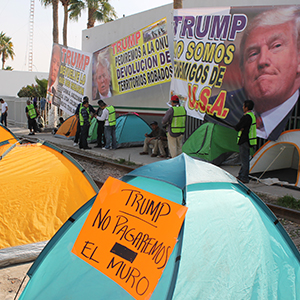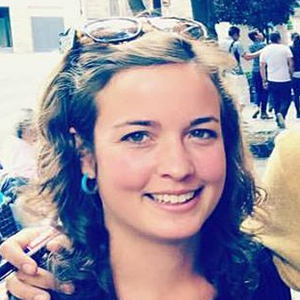Tijuana, Mexico— Two weeks after President Donald Trump took the oath of office in the White House, and a week after he signed an executive order to move forward with building a wall along the US border with Mexico, migrant shelters in Tijuana are prepare to bear the brunt of events 4,500km north-east in Washington DC.
“Physical walls don’t accomplish anything other than ecological damage, and emotional damage,” says Gilberto Martínez Amaya, the coordinator of the Casa del Migrante shelter. He explains that due to corruption and the ingenuity of migrants and coyotes - the nickname given to people who smuggle immigrants into the US, there is always a way to circumnavigate a wall.
The shelter for migrants, perched on a hill east of downtown, is run by the Congregation of the Missionaries of St Charles (Scalibrini) religious order and serves immigrants and deportees in Mexico’s largest border city. It was founded in 1987 to serve as a resting point for Mexicans heading north to work in the United States. The Scalabrini order specifically serves migrants around the world, and runs numerous shelters across Mexico.
The Casa del Migrante has capacity for 140 people, but in recent months the population has swelled to 200 on busy days.
“The help the Government has offered has been minimal,” says Martínez Amaya. “The burden has really fallen on civil society.”
The Tijuana-San Diego region of the border - forced right up against the Pacific Ocean - was one of the first to be militarised and fortified, beginning in 1994. Two layers of fencing separate Tijuana from neighbouring San Diego. It is the busiest land border crossing in the world. Mexican immigrants had a tendency to be seasonal - working during the summer in the US before ducking back across the border to spend the winter with their families. But after the terror attacks on 11 September 2001, the Mexico-US border was strengthened enforcing a change in immigration patterns. More Mexicans chose to stay permanently in the US, sending money home instead of returning to Mexico at the end of thw work season, and eventually bringing their families across.
Mexican immigrants had a tendency to be seasonal - working during the summer in the US before ducking back across the border to spend the winter with their families. But after the terror attacks on 11 September 2001, the Mexico-US border was strengthened enforcing a change in immigration patterns. More Mexicans chose to stay permanently in the US, sending money home instead of returning to Mexico at the end of thw work season, and eventually bringing their families across.
Meanwhile, the number of deportations skyrocketed. Today, more Mexicans return either voluntarily or by deportation, than the number crossing to the US.
From 2009 to 2015, President Obama deported 2.5 million people from the United States. During this period, yearly deportations to Tijuana could top 60,000. Tijuana receives the most deportees of any border city.
The Madre Assunta Institute was founded in 1994 when the bishop of Tijuana invited the Scalibrini nuns to open a centre for female migrants.
“The face of migration has changed,” explains Mary Galvan, the coordinator of Madre Assunta. “Today we see many families separated by migration.”
Women who have been deported arrive at Madre Assunta, as well as Mexican and Central American women seeking to cross to the United States. They stay an average of 15 days, during which they receive legal and psychological services in addition to food and shelter.
The shelter is in a large house, next to the San Felipe de Jesún parish and the Casa del Migrante men’s shelter. Mary Galvan says around 100 people are currently staying at Madre Assunta, including 62 Haitians.
----
In downtown Tijuana, in an office just feet from the San Isidro border crossing, Maria Galleta is putting on a pot of coffee, and handing out sandwiches to three Haitian men who have arrived seeking help and advice.
Organisations in Tijuana have been overwhelmed by the arrival of thousands of Haitians, which began in May 2016. Most of the Haitians came from Brazil, where they had found work following the devastating 2010 earthquake in Haiti. However, the economic and political crisis in Brazil forced thousands to leave, and head north to the US. Until September 2016, the US offered humanitarian protection to Haitians.
When this special protection was repealed, Haitians began staying longer in Tijuana. Since President Donald Trump took office, many have given up hope of entering the US and have decided to stay in Mexico. Organisations in Tijuana estimate 5,000 Haitians remain in the city.
One of the men in Maria’s office explains he no longer has plans to cross to the US because he doesn’t want to be deported back to Haiti. He came to the office to register for a Spanish class.
Liliana Quiroz Garibay, 32, is sitting in the Deported Mothers office in downtown Tijuana. She has lived here for a year, and volunteers for the organisation, which supports women deported from the US, many of whom left behind their children who are American citizens.
Liliana was born in Mexico City and her parents brought her to San Diego when she was five years old. When the father of her two children began to abuse her, she went to the San Diego police. But due to her undocumented status she felt they would not protect her, and so she left the US city and travelled to Tijuana.
Liliana’s four-year-old son is with her, but her eight-year-old daughter stayed in San Diego. It has been a year since she saw her daughter, and she has sought out lawyers to help her gain custody while living in Tijuana.
“It’s hard being here in Tijuana, it’s not like what I expected. I speak Spanish but sometimes I get confused writing. I lived my whole life in San Diego,” Liliana says.
Donald Trump’s entrance to the White House is the latest in a series of challenges for the organisations that serve migrants in Tijuana. Massive deportations and the wave of Haitians migrants already had the city on the brink during 2016.
Fr Pay Murphy of the Casa del Migrante wrote during 2016, citing Luke 10:25: “It is very clear in this moment, who is my neighbour. It is the displaced people who live in the streets of Tijuana, and now is the time that we act like Good Samaritans and give them a hand.”
For all previous Tablet World dispatches click here
10 February 2017, The Tablet
Organisations in Tijuana have been overwhelmed by the arrival of thousands of Haitians
 Loading ...
Loading ...




What do you think?
You can post as a subscriber user ...
User comments (0)